Closed royal crown


Cavalry Regiment Alcantara, royal crown
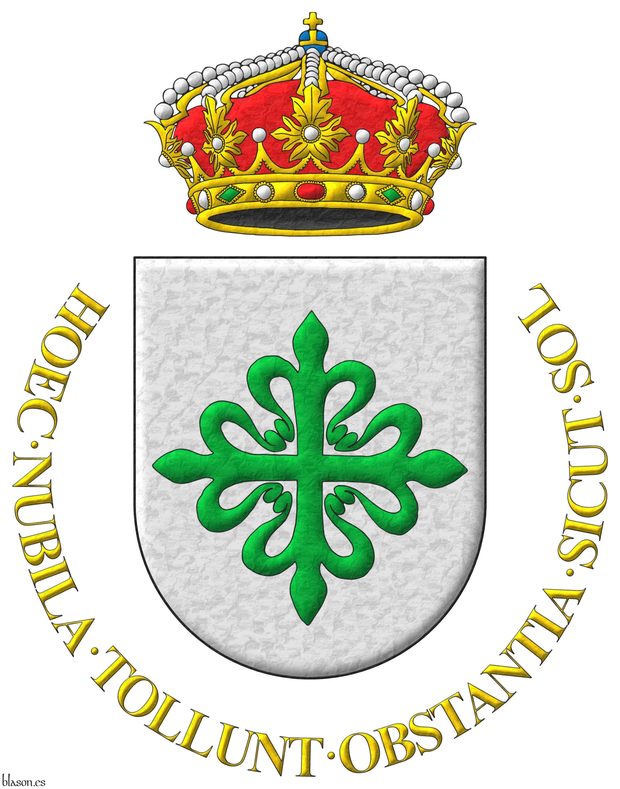
Disperse like the sun clears the clouds in your path.
Argent, a cross of Alcantara. Crest: A closed royal crown Or, with eight arches, visible five. Motto: «Hoec nubila tollunt obstantia sicut sol».
Escudo de plata, una cruz de Alcántara. Timbrado de una corona real cerrada. Lema: «Hoec nubila tollunt obstantia sicut sol».
Coat of arms interpreted in the following manner: the shape of the shield is of a semicircular arch; the field is illuminated in metal Argent; the cross of Alcantara is outlined in Sable and illuminated in Vert; the royal crown is closed, outlined in Sable and illuminated with the metal Or, Argent for the pearls, Azure and Or for the orb, Gules and Vert for the gems, Gules for the inner cloth, and Sable for the visible hollow at its base; and the whole has a slightly hammered metal finish.
Regiment's Motto
The Latin motto «Hoec nubila tollunt obstantia sicut sol» is often translated as «Ride like the sun, disperses the clouds in its path». I would like to offer the following observations on this translation:
- Instead of «disperse», I prefer the verb «scatter» which is more aligned with a cavalry regiment, [Royal Spanish Academy; 2001] «scatter, 3rd meaning, transitive verb, military term: To break up, rout the enemy, causing them to flee and scatter in complete disorder».
- On the other hand, even though it is about cavalry, I do not find that the Latin motto makes reference to riding, a verb that is also not needed to understand the motto's meaning, and adding an extra word lengthens the motto, reducing its impact.
- Finally, I use «your», instead of «its», so that the motto is a direct and personal rallying cry and not a phrase directed at a third person.
Blazon keywords: Without divisions, Argent, Cross of Alcantara, Cross couped, Cross, Crest, Closed royal crown, Crown and Motto.
Style keywords: Semi-circular, Illuminated, Outlined in sable and Soft metal.
Classification: Interpreted, Military, Army and Navy and Coat of arms.
Bearer: Alcantara, Cavalry Regiment.


Cavalry Regiment Montesa, royal crown

In this sign, you shall conquer.
Argent, a cross of Montesa. Crest: A closed royal crown Or, with eight arches, visible five. Motto: «In hoc signo vinces».
Escudo de oro, una cruz de Montesa. Timbrado de una corona real cerrada. Lema: «In hoc signo vinces».
Coat of arms interpreted as follows: the shape of the shield is a semi-circular arch; the field has been illuminated in metal Or; the cross of Montesa is outlined in Sable and illuminated in Sable and Gules; the royal crown is closed, outlined in Sable and illuminated the metal in Or, the pearls in Argent, the orb in Azure and Or, the gemstones in Gules and Vert, the inner cloth in Gules, and the visible hollow at its base in Sable; and the whole has a slightly beaten metal finish.
Regimental Motto
The Latin motto «In hoc signo vinces» is translated as «In this sign, you shall conquer».
Globus cruciger ~ Orb
It is called orb ~ «globus cruciger», the first in Spanish and the second in Latin, referring to the part of the royal crown, a jewel, or a jewel itself that recreates the shape of the globe topped with a cross.
Blazon keywords: Without divisions, Or, Cross of Montesa, Cross couped, Cross, Crest, Closed royal crown, Crown and Motto.
Style keywords: Semi-circular, Illuminated, Outlined in sable and Soft metal.
Classification: Interpreted, Military, Army and Navy and Coat of arms.
Bearer: Montesa, Cavalry Regiment.


![Ver [Corps of the Nobility of the Principality of Asturias in Twelve Lineages] en enlaces recomendados. Áncora de oro y la divisa enlace.](../css/Ancora.Enlace.png)
Corps of the Nobility of the Principality of Asturias in Twelve Lineages
Publication of my heraldic artwork on the blog Twelve Lineages of Soria under the following headline: Coat of arms of the Corps of the Nobility of the Principality of Asturias, work by Dr. Antonio Salmerón Cabañas.
Categories: Link, Freehand, Closed royal crown, Crown, Gules, Azure, Vert, Sable, Purpure, Or, Argent, Oval, Bordure, Motto, Motto (identification), Horse, Rampant, Flag, Helm and Fleur de lis.
Root: Twelve Lineages of Soria.


Crown of Castilla-La Mancha
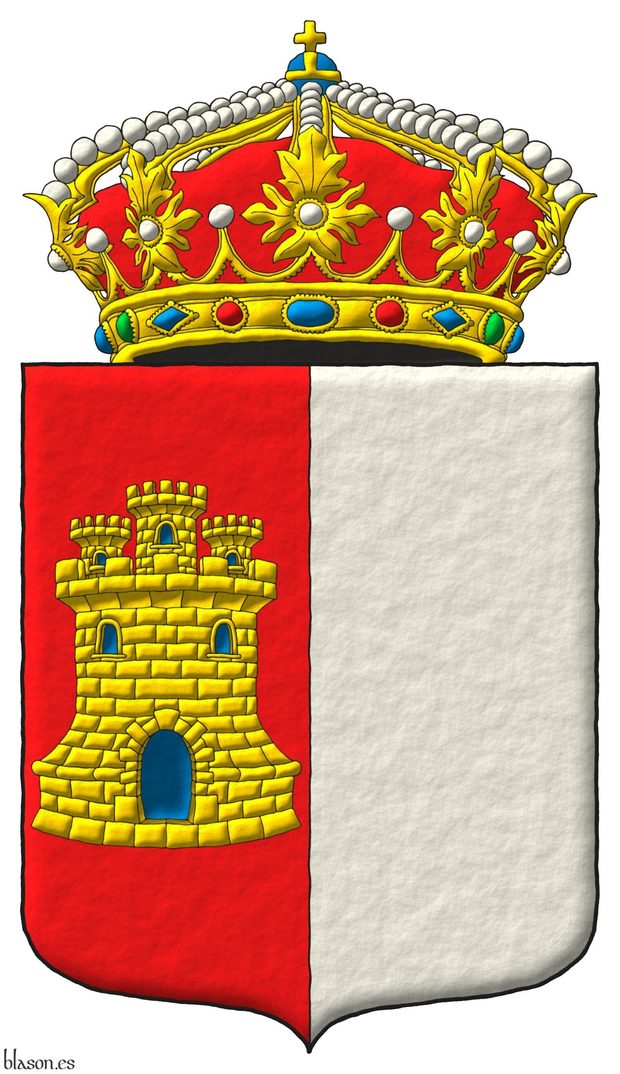
Party per pale: 1 Gules, a castle triple-towered Or, port and windows Azure, masoned Sable; 2 Argent. Crest: A closed royal crown Or.
Coat of arms emblazoned by me, highlighted with lights and shadows, contoured in Sable, with an ogee external shape and with a freehand finishing.
Design rationale
The coat of arms of Castilla-La Mancha was adopted in 1983, it is a recent design. This coat of arms is equal to the flag of Castilla-La Mancha officially approved in 1980 and designed by Ramón José Maldonado y Cocat. The 1st quarter represents Castilla and the 2nd quarter the great plane of La Mancha.
Blazon keywords: Gules, Argent, Or, Azure, Sable, One, Party per pale, Castle, Triple-towered, Port and windows, Masoned, Crest, Closed royal crown and Crown.
Style keywords: Outlined in sable, Illuminated, Ogee and Freehand.
Classification: Civic, Interpreted, Design rationale, Boa and Coat of arms.
Bearer: Castilla-La Mancha.


Crown of Crepsi
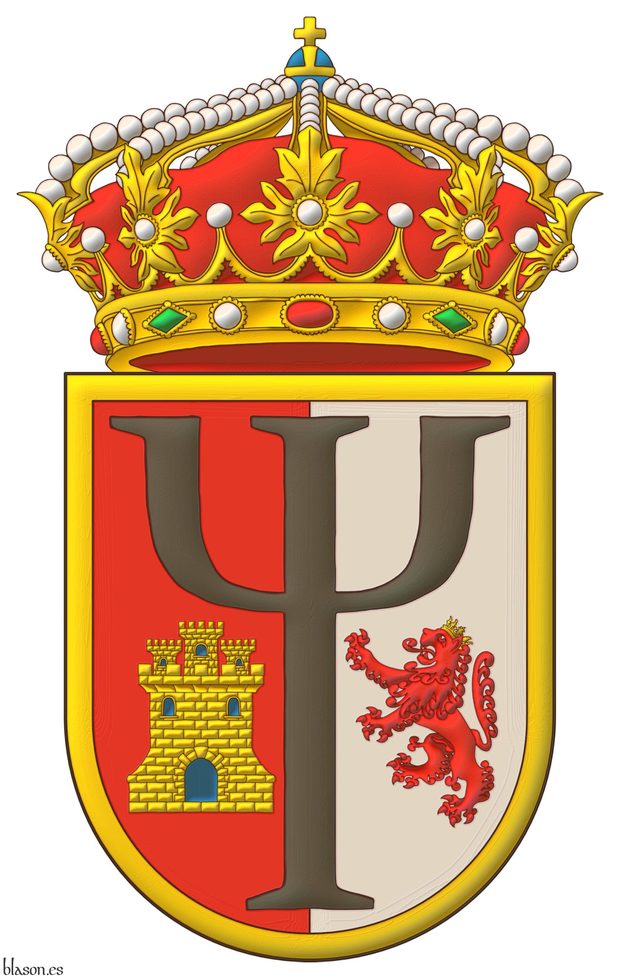
Party per pale: 1 Gules, in base a castle triple-towered Or, port and windows Azure, and masoned Sable; 2 Argent, in base a lion rampant Gules, crowned Or; overall a psi letter sable; a diminished bordure Or. Crest: A closed royal crown.
Coat of arms emblazoned by me, illuminated with lights and shadows, outlined in Sable, with a semi-circular external shape and with a texturized finishing.
Coat of arms of Crepsi, designed by my lieutenant colonel and friend Miguel Angel Nuñez Amador and emblazoned by me.
Blazon keywords: Gules, Argent, Or, Azure, Sable, Party per pale, In base, Castle, Triple-towered, Port and windows, Masoned, Lion, Rampant, Crowned, Overall, Letter, Diminished bordure, Closed royal crown and Crown.
Style keywords: Outlined in sable, Illuminated and Semi-circular.
Classification: Military, Interpreted, Boa and Coat of arms.
Bearer: Crepsi.


Crown of the city of Almeria
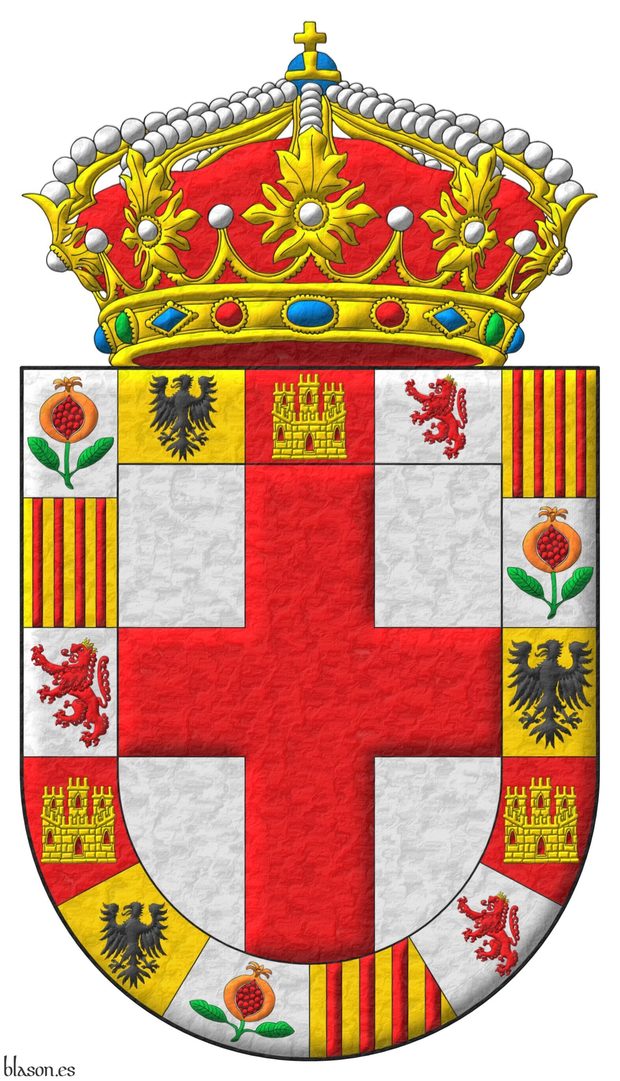
Argent, a cross Gules; a bordure compony of fifteen sections: 1, 6, and 11 Argent, a pomegranate seeded, slipped and leaved proper; 2, 7, and 12 Or, an eagle displayed Sable; 3, 8, and 13 Gules, a castle triple-towered Or, port and windows Gules, masoned Sable; 4, 9, and 14 Argent, a lion rampant Gules, crowned Or; 5, 10, and 15 Or, four pallets Gules. Crest: A closed royal crown.
Coat of arms interpreted by me, illuminated with lights and shadows, contoured in Sable, with a semi-circular external shape and with a metal beaten finishing.
Coat of arms of the city of Almeria, Andalusia, emblazoned by me. The island of Alboran is geographically part of Africa, but politically it belongs to the city of Almeria. As a result, Almeria is one of the few cities in the world that spans two continents: Europe and Africa.
Blazon keywords: Argent, Gules, Or, Sable, Vert, One, Four, Fifteen, Cross, Bordure, Compony, Pomegranate, Slipped, Leaved, Proper, Eagle, Castle, Triple-towered, Port and windows, Masoned, Lion, Rampant, Crowned, Pallet, Closed royal crown and Crown.
Style keywords: Outlined in sable, Illuminated, Semi-circular and Metal beaten.
Classification: Civic, Interpreted, Boa and Coat of arms.
Bearer: Almeria, city of.


Crown of the municipality of Candasnos

Party per fess, the base per pale: 1 Or, a hurt; 2 Gules and 3 Argent, over both a cross of Malta counterchanged. Crest: A closed royal crown.
Coat of arms painted by me, illuminated with lights and shadows, outlined in Sable, and with a freehand finish.
Arms of the municipality of Candasnos, Huesca, designed by Valeriano Labara Ballestar, approved by the Government of Aragon. It has been an honor for me to emblazon this version for Valeriano Labara. Bibliographic reference [Labara Ballestar, V. C.; 2019; pages 341-368].
Design rationale
The hurt represents what is known as the Good Raft, a symbol of the town and its people, it is a circular cistern of 40 meters in diameter of Roman origin, and the Maltese cross is a symbol of its connection since 1188 to the Royal Monastery of Sijena of Hospitaller nuns of the Order Malta.
Blazon keywords: Or, Azure, Gules, Argent, One, Party per fess, the base per pale, Hurt, Eight-pointed cross, Cross couped, Counterchanged, Crest, Closed royal crown and Crown.
Style keywords: Outlined in sable, Illuminated and Freehand.
Classification: Civic, Interpreted, Design rationale, Boa and Coat of arms.
Bearer: Candasnos, municipality of.


Royal Association of Hidalgos of Spain, emblem

Emblem, two two-handed swords in saltire Argent, hilted Or. Crest: A royal crown Or.
Emblema, dos mandobles en sotuer de plata, guarnecidos de oro. Timbrado de una corona real.
Emblem interpretation with: the two-handed swords placed along the diagonals of an imaginary rectangle, with a 5x6 proportion, like a shield, that is, with angles of 50.2°, between the axis of the two-handed swords and the imaginary base of the emblem, unlike the original emblem where the two-handed swords are on the diagonals of a square, therefore with angles of 45°; the two-handed swords and the closed royal crown are outlined in Sable, illuminated and the whole with a raised-stroke execution.
This emblem of the Royal Association of Hidalgos of Spain has 2 two-handed swords that, unlike usual swords, due to their great length and weight, their fencing must be two-handed, hence their name.
The Spanish word «mandoble» comes from «mano doble», meaning «double hand», and refers to a sword wielded with both hands, the equivalent of the English «two-handed sword».
It is known that they are two-handed swords because the 2 that appear in the emblem have a crescent or crossguard in their iron. This crescent is called in Castilian «falsaguarda» and also «ganchos de parada» and its functionality is to protect from the slashes that the opponent could give close to the blade of the two-handed sword.
Blazon keywords: Two-handed sword, Argent, Hilted, Or, In saltire, Crest, Closed royal crown and Crown.
Style keywords: Illuminated, Outlined in sable and Freehand.
Classification: Interpreted, Socioeconomic and Emblem.
Bearer: Royal Association of Hidalgos of Spain.


Royal Spanish Academy, coat of arms

Argent, a crucible Argent, enflamed and on a bonfire hoguera Gules and Or. Crest: A closed royal crown Or, with eight arches, visible five. Motto: «Limpia, fixa, y da esplendor» Or over a scroll Azure.
Escudo de plata, un crisol de plata, llameante y sumado a una hoguera de gules y oro. Timbrado de una corona real cerrada. Lema: «Limpia, fixa, y da esplendor» de oro sobre una filacteria de azur.
Interpretation made from the Royal Academy emblem: transforming it into a semicircular-based shield, instead of its oval shape; with its motto on a scroll beneath the base, instead of surrounding it; keeping the closed royal crown in its place; with everything illuminated except the field which is in plain color; and the whole outlined in sable and with a parchment-like finish.
In this interpretation, on the Argent field, the Gules fire of the bonfire completely surrounds the Argent crucible, to avoid the metal Argent on the same.
To write the blazon for this coat of arms I use the heraldic term «llameante». Therefore, I do not follow [Avilés, J.; 1780a; page 82 and figure 163] when he writes «...y un Fénix de gules sobre una hoguera encendida de lo mismo.». He uses this example to illustrate the 2 fundamental uses of the term «encendido» which is said when «the Eyes of animals... are of a different color» and «also of a burning Bush and the same for a Torch, when the flame is of a different tincture».
Blazon keywords: Without divisions, Argent, One, Crucible, Enflamed, Bonfire, Gules, Or, Closed royal crown, Crown, Motto, Scroll and Azure.
Style keywords: Semi-circular, Illuminated, Outlined in sable and Parchment.
Classification: Interpreted, Socioeconomic and Coat of arms.
Bearer: Royal Spanish Academy.


![Ver [Royal Spanish Academy; 2014] en referencias bibliográficas. Libro abierto, hojas de plata, filo de oro, guardas de gules, tapas de sable.](../css/Libro.Bibliografia.png)
Royal Spanish Academy; 2014
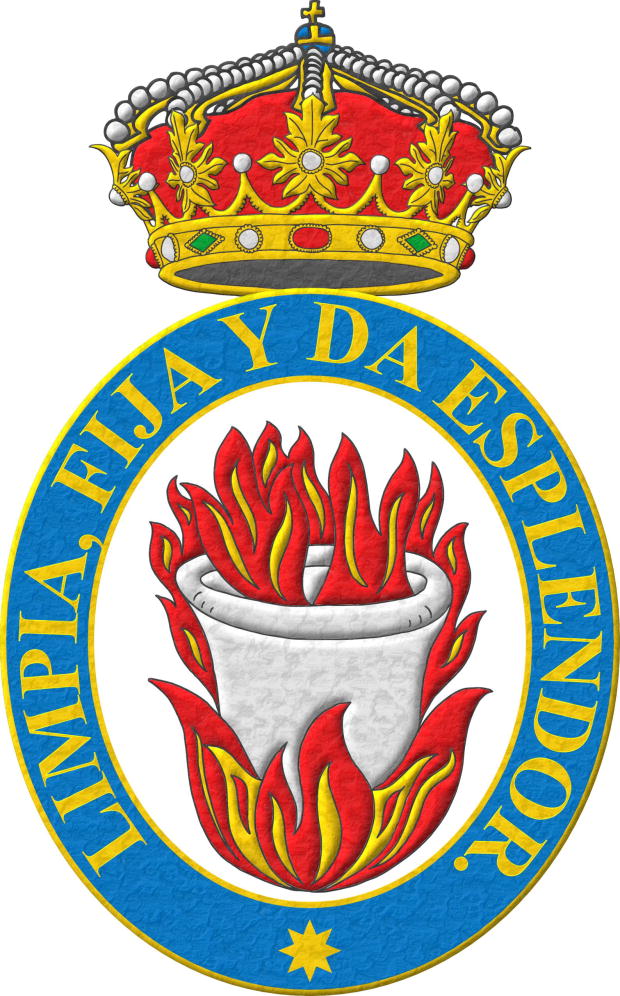
Real Academia Española, «Diccionario de la lengua española», known as DRAE, acronym for Diccionario de la Real Academia Española, 23rd edition, Espasa Calpe, Madrid, 2014.
This bibliographic reference of the DRAE is illustrated with one of my interpretations of the emblem of the Real Academia Española. Oval emblem with its crucible over a bonfire, surmounted by a closed Royal crown and its motto «Limpia, fija y da esplendor», around the emblem in letters of Or on Azure.
Bibliographical reference of century XXI.
Classification: Dictionary and Castilian language.
Author: Royal Spanish Academy.
Bibliographical reference mentioned in the following article:
External resource:


![Ver [Zamora Vicente, A.; 1999] en referencias bibliográficas. Libro abierto, hojas de plata, filo de oro, guardas de gules, tapas de sable.](../css/Libro.Bibliografia.png)
Zamora Vicente, A.; 1999
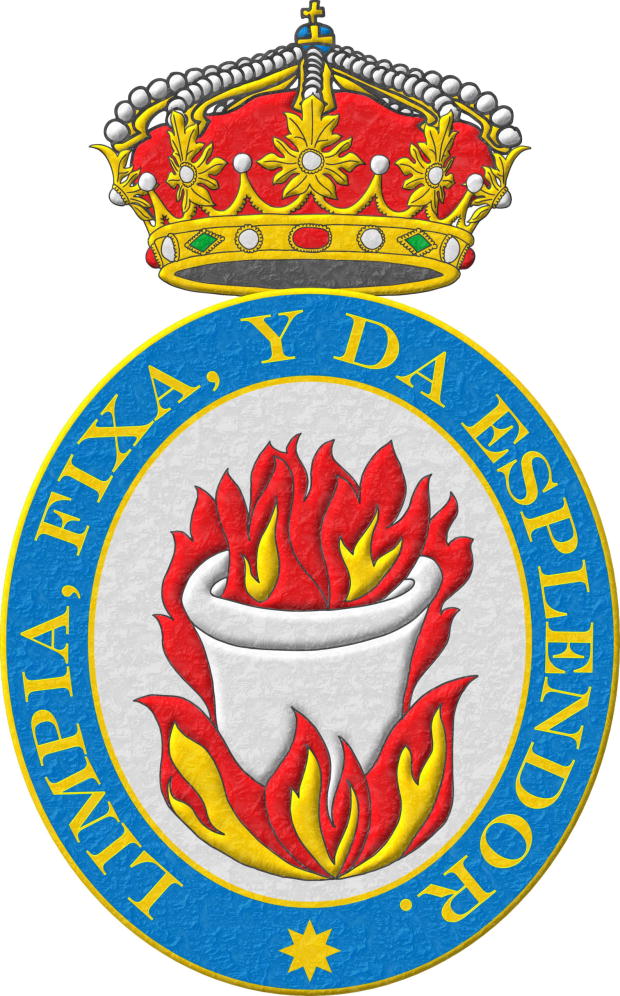
Alonso Zamora Vicente, «Historia de la Real Academia Española», Real Academia Española, Espasa Calpe, Madrid, 1999.
This bibliographic reference is illustrated with one of my interpretations of the emblem of the Real Academia Española. It is an oval emblem in Argent, with its crucible, also in Argent, over a bonfire of Gules and Or and surrounded by its flames, surmounted by a closed Royal crown with 8 arches, 5 of which are visible, and its motto, as originally written «Limpia, fixa, y da esplendor», around it.
Bibliographical reference of century XX.
Classification: Castilian language.
The author is Zamora Vicente, Alonso.
The following article cites this bibliographic reference:
External link:
-
Language
-
Categories of heraldry
-
Divisions of the field
- Without divisions
- Party per pale
- Party per fess
- Party per bend
- Party per bend sinister
- Tierce
- Tierce sinister
- Tierced per pale
- Tierced per fess
- Tierced per bend
- Tierced pallwise inverted
- Quarterly
- Quarterly per saltire
- Gyronny
- Party per fess, the chief per pale
- Party per pale, the sinister per fess
- Party per fess, the base per pale
- Party per pale, the dexter per fess
- Chapé
- Chaussé
- Embrassé
- Contre-embrassé
- Party per chevron
- Enté
- Enté en point
- Flanched
-
Metals
-
Colours
-
Furs
-
Other tinctures
-
Ordinaries and sub-ordinaries
-
Diminutives of the ordinaries
-
Other charges
-
Inanimate charges from Nature
Atom, Crescent, Diamond, Emerald, Estoile, Increscent, Lightning flash, Moon, Mount, Mullet, Mullet of four points, Orbital, Plough of Ursa Major, Rainbow, Ray of the sun, River, Sea, Snowflake, Sun, Sun in splendour, Trimount and Water.
-
Vegetal charges from Nature
Acorn, Apple, Apple tree, Ash, Bluebonnet, Camellia, Chrysanthemum, Cinquefoil, Cornflower, Dogwood flower, Double rose, Elm, Fleur de lis, Flower, Holm oak, Hop cone, Kapok tree, Laurel, Lily, Linden, Lotus flower, Madonna lily, Oak, Olive tree, Palm tree, Pomegranate, Poplar leaf, Rose, Shamrock, Sunflower, Thistle, Tree, Tulip, Vine and Wheat.
-
Animal charges from Nature
Badger, Bald eagle, Barbel, Barn owl, Bear, Beaver, Beetle, Bighorn sheep, Blackbird, Boar, Brach hound, Bull, Doe, Dog, Dolphin, Dove, Eagle, Elephant, Falcon, Fish, Flame, Fly, Fox, Frog, Goat, Goldfinch, Goose, Heron, Horse, Hummingbird, Jaguar, Lark, Leopard, Lion, Lion passant, Lion rampant guardant, Lioness, Lynx, Male figure, Martlet, Merino ram, Owl, Panther, Parrot, Peacock, Pelican, Pelican in her piety, Puffin, Quetzal, Raven, Roe deer, Rooster, Savage, Seagull, Serpent, She-wolf, Stag, Starling, Tyger, Vulture, Warren hound and Wolf.
-
Parts of natural charges
Arm, Beak, Branch, Caboshed, Chest, Claw, Covert, Dorsal fin, Eagle claw, Ermine spot, Escallop, Feather, Foot (palmiped), Foreleg, Forepaw, Hand, Head, Heart, Hoof, Leaf, Neck, Ostrich feather, Palm frond, Paw, Roe deers' attires, Shoulder, Sprig, Stags' attires, Stem, Swallow-tail, Tail, Tail addorsed, Tail fin, Talon, Tooth, Trunk, Trunk (elephant), Two hands clasped, Two wings in vol, Udder, Wheat spike, Wing and Wrist.
-
Artificial charges
Ace of spades, Anchor, Anvil, Arch, Arm vambraced, Armillary sphere, Arrow, Axe, Bell, Bell tower, Beret, Bonfire, Book, Bookmark, Bow, Bridge, Broken, Buckle, Cannon, Cannon dismounted, Cannon port, Carbuncle, Castle, Celtic Trinity knot, Chain, Chess rooks, Church, Clarion, Clay pot, Closed book, Club, Comb, Compass rose, Conductor's baton, Cord, Covered cup, Crozier, Crucible, Cuffed, Cup, Cyclamor, Dagger, Double vajra, Drum, Ecclesiastical cap, Fanon, Federschwert, Fleam, Four crescents joined millsailwise, Galician granary, Garb, Gauntlet, Geometric solid, Grenade, Halberd, Hammer, Harp, Host, Hourglass, Key, Key ward, Knight, Knot, Lantern, Letter, Line, Loincloth, Menorah, Millrind, Millstone, Millwheel, Monstrance, Mortar, Mullet of six points pierced, Nail, Non-classic artifact, Norman ship, Number, Oar, Oil lamp, Open book, Page, Pair of scales, Parchment, Pestle, Piano, Plough share, Polish winged hussar, Portcullis, Potent, Quill, Ribbon, Rosette of acanthus leaves, Sabre, Sackbut, Sail, Scroll, Scythe, Sheaf of tobacco, Ship, Skirt, Spear, Spear's head, Star of David, Sword, Symbol, Tetrahedron, Torch, Tower, Trident, Trumpet, Turret, Two-handed sword, Wagon-wheel, Water-bouget, Wheel, Winnowing fan and With a turret.
-
Immaterial charges
Angel, Archangel, Basilisk, Dragon, Dragon's head, Garuda, Golden fleece, Griffin, Heart enflamed, Mermaid, Our Lady of Mercy, Ouroboros, Paschal lamb, Pegasus, Phoenix, Sacred Heart of Jesus, Saint George, Sea-griffin, Trinity, Triton, Unicorn, Winged hand and Wyvern.
-
External elements
-
Heraldic creations
-
References
-
Formats
-
Keywords on this page
Port and windows, Proper, Alcantara, Cavalry Regiment, Almeria, city of, Azure, Bibliography, Boa, Bordure, Castle, Crest, Crown, Closed royal crown, Crowned, Crucible, Cross, Cross couped, Triple-towered, Outlined in sable, Within, Army and Navy, Emblem, Coat of arms, Scroll, Gules, Bonfire, Illuminated, Interpreted, Motto, Castilian language, Lion, Enflamed, Masoned, Semi-circular, Soft metal, Military, Or, Oval, Party per pale, Fimbriated, Argent, Without divisions, Civic, Rampant, Sable, Design rationale, Vert, Socioeconomic, Freehand and One.
